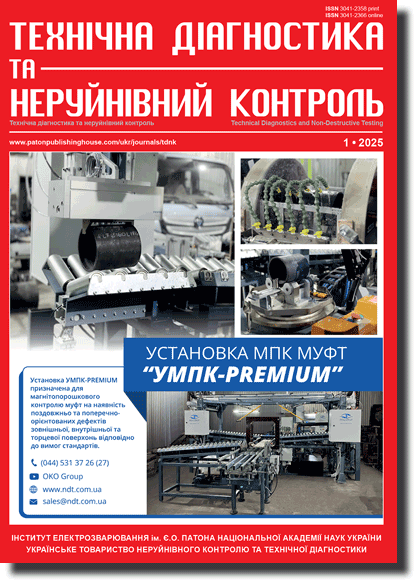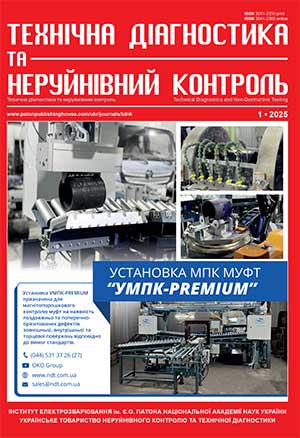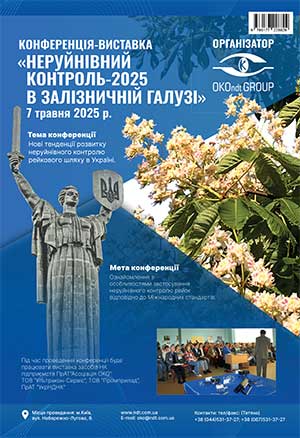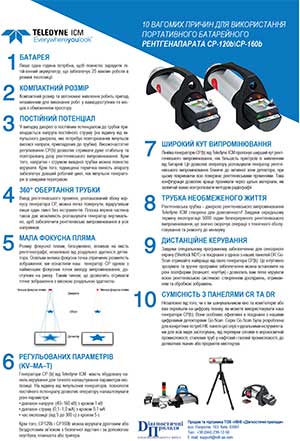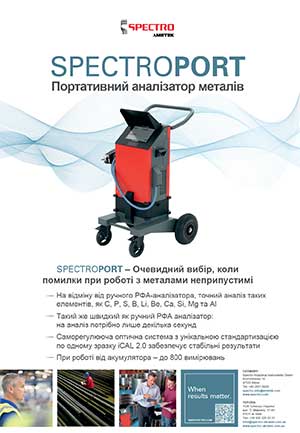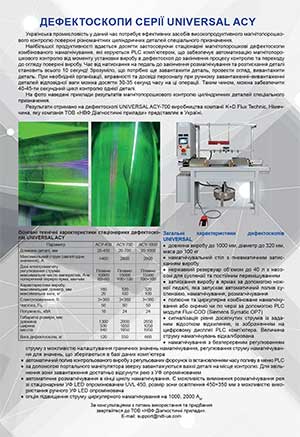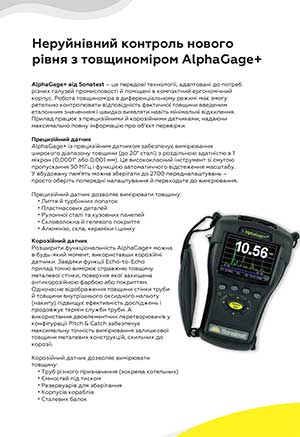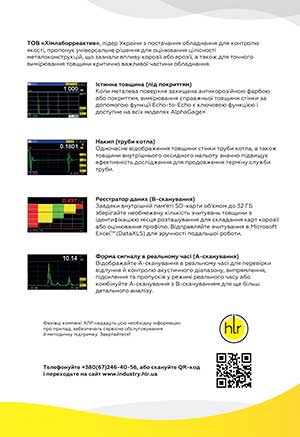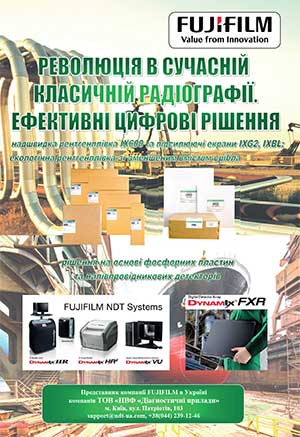Access for download PDF files for subscribers and for reviewers of scientometric bases.
Organization: Elsevier for content access(PDF files of journals released before 2024 are available for download from the website's archives))
Organization: Elsevier for content access(PDF files of journals released before 2024 are available for download from the website's archives))
| 2025 №01 (01) |
DOI of Article 10.37434/tdnk2025.01.02 |
2025 №01 (03) |

"Tekhnichna Diahnostyka ta Neruinivnyi Kontrol" (Technical Diagnostics and Non-Destructive Testing) #1, 2025, pp. 10-15
Evaluation of microscopic defects in hydraulic turbine blade coatings
C.A. Tugui1, A. Savin2, V.M. Uchanin3
1Materials Processing Technologies and Equipment Department, Gheorghe Asachi Technical University, Iași, Romania. E-mail: tzugui.andrei@yahoo.com2Nondestructive Testing Department, National Institute of Research and Development for Technical Physics, Iasi, Romania. E-mail: asavin@phys-iasi.ro
3G.V. Karpenko Physico-Mechanical Institute of the NAS of Ukraine NASU. 5 Naukova str., 79060, Lviv, Ukraine. E-mail: vuchanin@gmail.com
Hydro-abrasive wear is a major problem for the efficiency and durability of Francis turbines, widely used in hydroelectric power plants due to their ability to transform hydraulic energy into sustainable electricity. Constantly exposed to abrasive particles in water, turbine components are subjected to intense stresses, which lead to progressive deterioration and shortening of their lifespan. In this context, scanning electron microscopy (SEM) analysis becomes an essential tool for the evaluation and understanding of microscopic defects induced by hydro-abrasive wear. SEM allows for the detailed characterization of the affected surfaces and the identification of the types of damage, thus providing fundamental data for the optimization and selection of abrasion-resistant materials. Thermal spray of materials, such as Metco 71VF-NS (WC12Co) are an important solution in combating wear, being renowned for their increased hardness and strength. These sprayed layers not only protect the turbines from the effects of hydro-abrasive wear, but also contribute to the overall efficiency of the system by reducing the frequency of repairs and maintenance. Thus, in the context of renewable energy, where reliability and durability of equipment are essential, the use of advanced materials to protect Francis turbines represents a crucial step towards sustainable and efficient production of electricity based on hydraulic resources. 22 Ref., 2 Tabl., 5 Fig.
Keywords: thermal spraying, coatings, SEM, structure, thickness, porosity
Received: 27.11.2024
Received in revised form: 21.02.2025
Accepted: 22.03.2025
References
1. Sangal, S., Singhal, M., Saini, R.P. (2018) Hydro-abrasive erosion in hydro turbines: A review. International J. of Green Energy, 15(1), 232-253. https://doi.org/10.1080/15435075.2018.14315462. Rai, A., Kumar, A., Staubli, T. (2018) Design and verification of a Pelton turbine rig for hydroabrasive erosion testing. In: Conference «Current Research in Hydraulic Turbines» (CRHT-VIII-2018), June 2018, Kathmandu, Nepal
3. Arora, N., Kumar, A., Singal, S. (2024) Hydroabrasive erosion in Kaplan turbines: A case study. J. of Hydroinformatics, 26(9), 2251-2260. https://doi.org/10.2166/hydro.2024.096
4. Felix, D., Albayrak, I., Boes, R., Abgottspon, A. (2017) Sediment transport through the power waterway and hydroabrasive erosion on turbines. In: Conference «Hydro 2017», October 2017, Seville, Spain. Volume: E-Proceedings, paper №27.07.
5. Pitkänen, J., Hakkarainen, T., Jeskanen, H., Kuusinen, P., Lahdenperä K., Särkiniemi P., Kemppainen, M., Pihkakoski M. (2000) NDT methods for revealing anomalies and defects in gas turbine blades. In: 15th World Conf. on Nondestructive Testing, Rome, 2000 www.ndt.net/article/wcndt00/papers.
6. Mook, G., Simonin, J., Feist, W.D., Hinken, J.H., Perrin, G. (2006) Detection and characterization of magnetic anomalies in gas turbine disks. In: Proceedings of the 9th European Conference on NDT, Berlin, Germany, 25-29 September 2006.
7. Uchanin, V., Nardoni, G., Nardoni, P. (2024) Fatigue cracks detection in the fillet zone of steel blades of industrial gas turbines using eddy current method. The Paton Welding J., 7, 22-28. https://doi.org/10.37434/tpwj2024.07.04
8. Schnell, A., Germerdonk, K., Antonelli, G. (2007) A nondestructive testing method of determining the depletion of a coating. U.S. Patent № 7175720, Publ. 13.02.2007.
9. Antonelli, G. (2002) Non-destructive condition assessment of serviced MCrAlY coatings. Turbine Forum 2002, Nice-France, 2002.
10. Antonelli, G., Ruzzier, M., Necci, F. (1998) Thickness measurement of MCrALY high-temperature coatings by frequency scanning eddy current technique. J. of Engineering for Gas Turbines and Power, Transactions of ASME, 120, 537-542. https://doi.org/10.1115/1.2818180
11. Uchanin, V.M., Sidorenko, M.V. (2016) Investigation of eddy current method for detection and assessing changes in structure during grinding of heat-resistant steel components. Technical diagnostics and non-destructive testing, 4, 21-26. https://doi.org/10.15407/tdnk2016.04.04
12. Uchanin, V. (2000) Elevated frequencies in eddy currents - new possibilities of thin surface layer evaluation. In: 15th World Conf. on Nondestructive Testing, Rome, 2000 www.ndt.net/article/wcndt00/papers.
13. Uchanin, V.N. (1992) Eddy current device for inspecting changes in the structure in heat treatment of components of titanium alloys. Materials Science, 27, 442-443. https://doi.org/10.1007/BF00723242
14. İpek Ayvaz, S., Özer, E. (2023) Comparative study of conventional and microwave-assisted boriding of AISI 1040 and AISI 4140 steels. Tehnički Glasnik, 17(2), 286-292. https://doi.org/10.31803/tg-20221206210933
15. Hajian, M., Adivi, B., Jamali, M. (2024) Investigating the microstructure and wear properties of AISI 4140 steel clad with WC-Ti composite particles via gas tungsten arc welding. JOM, 76, 2824-2834. https://doi.org/10.1007/s11837-024-06471-z
16. Podgornik, B., Vizintin, J., Leskovšek, V. (1998) Tribological properties of plasma and pulse plasma nitrided AISI 4140 steel. Surface & Coatings Technology, 108-109, 454-460. https://doi.org/10.1016/S0257-8972(98)00571-4
17. Márquez-Cortés, R., Martínez-Trinidad, J., García-León, R. (2023) Adhesion behaviour of borided AISI 4140 steel. Surface Engineering, 38(10-11). https://doi.org/10.1080/02670844.2023.2180856
18. Godoy, C., Batista, J.C.A. (1999) Adhesion evaluation of plasma sprayed coatings using piecewise linear regression analysis. J. of Thermal Spray Technology, 8(4), 531-536. https://doi.org/10.1361/105996399770350214
19. Mann, B.S., Arya, V. (2001) Abrasive and erosive wear characteristics of plasma nitriding and HVOF coatings: Their application in hydro turbines. Wear, 249(5-6), 354-360. https://doi.org/10.1016/S0043-1648(01)00537-3
20. Qu, Q.-y., Qiu, W., Zeng, D.-c., Liu, Z., Dai, M.-j., Zhou, K.s. (2009) Effects of deposition parameters on microstructure and thermal conductivity of diamond films deposited by DC arc plasma jet chemical vapor deposition. Transactions of Nonferrous Metals Society of China, 19(1), 131-137. https://doi.org/10.1016/S1003-6326(08)60240-X
21. Sosnowy, P., Góral, M., Kotowski, S., Hanula, G., Gwizdała, J., Drzał, J., Kobylarz, M., Borowski, P., Gargała, R. (2015) The influence of temperature on erosion resistance of carbide coatings deposited by APS method. Solid State Phenomena, 227, 251-254. https://doi.org/10.4028/www.scientific.net/SSP.227.251
22. Kim, H. J., Kweon, Y. G., Chang, R. W. (1994). Wear and erosion behavior of plasma-sprayed WC-Co coatings. J. of Thermal Spray Technology, 3(2), 169-178. https://doi.org/10.1007/BF02648274
Advertising in this issue:
To order the electronic version of the paper:
C.A. Tugui, A. Savin, V.M. UchaninEvaluation of microscopic defects in hydraulic turbine blade coatings
Technical Diagnostics and Non-Destructive Testing №01 2025 p.10-15
The cost of article (pdf): 13 $, 12 €, 150 UAH (1 copy. )
fill in the form below:
The cost of subscription/purchase order journals or individual articles
| Journal/Currency | Annual Set | 1 issue printed |
1 issue |
one article |
| TPWJ/USD | 384 $ | 32 $ | 26 $ | 13 $ |
| TPWJ/EUR | 348 € | 29 € | 24 € | 12 € |
| TPWJ/UAH | 7200 UAH | 600 UAH | 600 UAH | 280 UAH |
| AS/UAH | 1800 UAH | 300 UAH | 300 UAH | 150 UAH |
| AS/USD | 192 $ | 32 $ | 26 $ | 13 $ |
| AS/EUR | 180 € | 30 € | 25 € | 12 € |
| SEM/UAH | 1200 UAH | 300 UAH | 300 UAH | 150 UAH |
| SEM/USD | 128 $ | 32 $ | 26 $ | 13 $ |
| SEM/EUR | 120 € | 30 € | 25 € | 12 € |
| TDNK/UAH | 1200 UAH | 300 UAH | 300 UAH | 150 UAH |
| TDNK/USD | 128 $ | 32 $ | 26 $ | 13 $ |
| TDNK/EUR | 120 € | 30 € | 25 € | 15 € |
AS = «Automatic Welding» - 6 issues per year;
TPWJ = «PATON WELDING JOURNAL» - 12 issues per year;
SEM = «Electrometallurgy Today» - 4 issues per year;
TDNK = «Technical Diagnostics and Non-Destructive Testing» - 4 issues per year.





